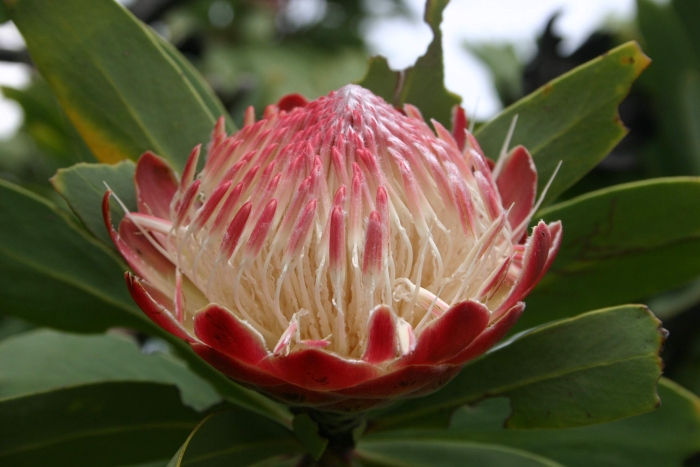Common Protea
(Protea caffra)
Common Protea (Protea caffra)
/
/

Paul venter
CC BY-SA 3.0
Image By:
Paul venter
Recorded By:
Copyright:
CC BY-SA 3.0
Copyright Notice:
Photo by: Paul venter | License Type: CC BY-SA 3.0 | License URL: https://creativecommons.org/licenses/by-sa/3.0 | Uploader: Paul venter | Publisher: Wikimedia Commons | Title: Protea_caffra06.jpg |























































Estimated Native Range
Summary
Protea caffra, commonly known as the Common Protea, is a small tree or shrub that is deciduous to semi-deciduous, depending on the climate. It is native to grasslands and open woodlands at high altitudes in Southern Africa. Protea caffra typically grows to a height of 3-8 meters with a similar spread, and it has a single trunk with a rounded crown. The leaves are leathery, hairless, and oblong with a bluish-green hue. The flower heads are showy and solitary or clustered in groups of 3 or 4, with involucral bracts that are pale red, pink, or cream, blooming from late winter to spring. The fruit is a densely hairy nut that follows the flowers.
The Common Protea is valued for its striking flowers and adaptability to a range of garden settings. It is often used in ornamental plantings, borders, and as a feature plant in gardens. The species is drought-tolerant and can survive in low-water conditions, making it suitable for xeriscaping. It thrives in full sun and requires well-drained soil, preferably acidic to neutral in pH. Protea caffra is also known for its ability to attract birds and insects, adding to the biodiversity of the garden. However, it can be susceptible to root rot if overwatered or planted in poorly drained soils. It is recommended to prune lower branches to stimulate flowering shoots and maintain a desirable shape.CC BY-SA 4.0
The Common Protea is valued for its striking flowers and adaptability to a range of garden settings. It is often used in ornamental plantings, borders, and as a feature plant in gardens. The species is drought-tolerant and can survive in low-water conditions, making it suitable for xeriscaping. It thrives in full sun and requires well-drained soil, preferably acidic to neutral in pH. Protea caffra is also known for its ability to attract birds and insects, adding to the biodiversity of the garden. However, it can be susceptible to root rot if overwatered or planted in poorly drained soils. It is recommended to prune lower branches to stimulate flowering shoots and maintain a desirable shape.CC BY-SA 4.0
Plant Description
- Plant Type: Shrub, Tree
- Height: 6-21 feet
- Width: 2-6 feet
- Growth Rate: Moderate
- Flower Color: Pink, Red
- Flowering Season: Summer, Winter
- Leaf Retention: Evergreen
Growth Requirements
- Sun: Full Sun
- Water: Low
- Drainage: Medium, Fast
Common Uses
Bee Garden, Bird Garden, Butterfly Garden, Drought Tolerant, Hummingbird Garden, Showy Flowers
Natural Habitat
native to grasslands and open woodlands at high altitudes in Southern Africa
Other Names
Common Names:
Scientific Names: , Protea caffra, Protea stipitata, Protea baurii, Protea ferrugineobracteata, Protea natalensis, Protea peglerae,
GBIF Accepted Name: Protea caffra Meisn.